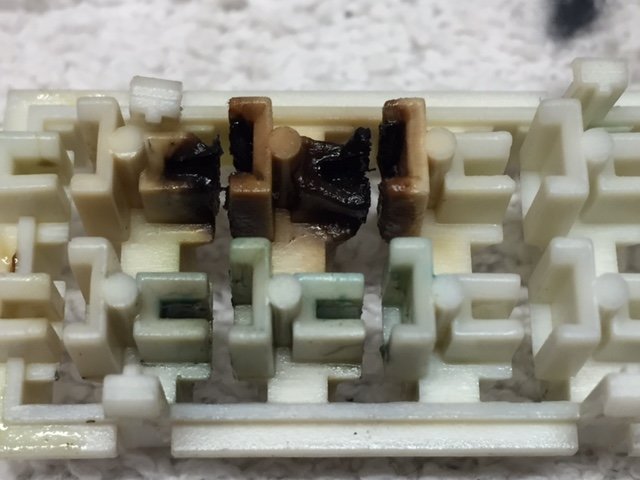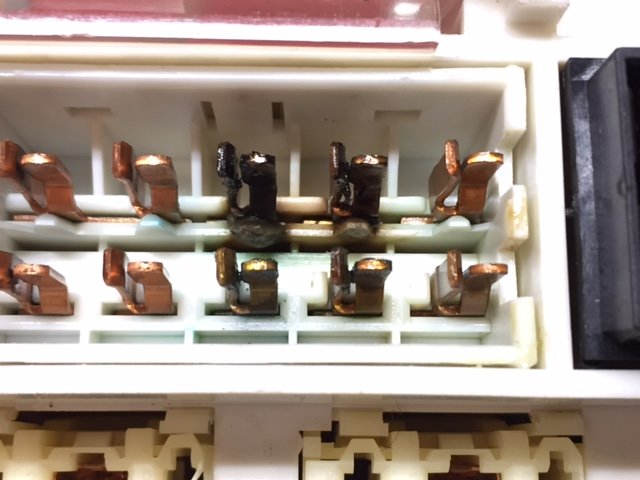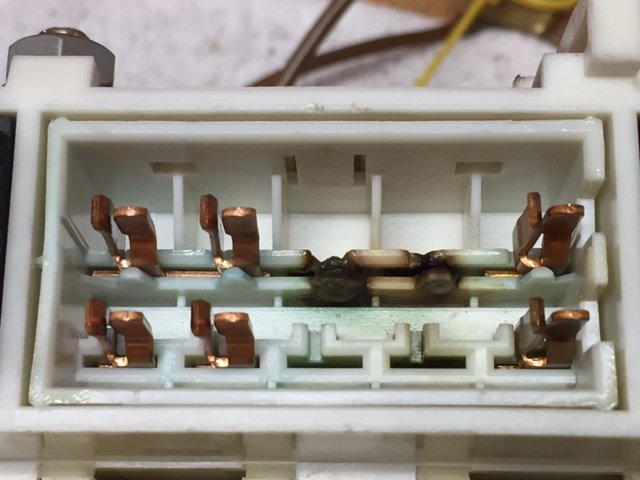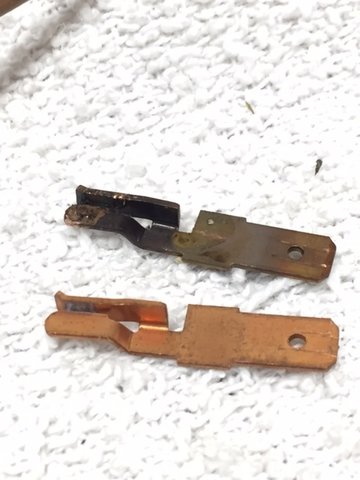
The fan motors draw a considerable amount of current directly from the battery via two 30A fuses (#28 and #29). Over time the contacts on the fuse paner can deteriorate, corrode and even melt or burn. A small contact resistance can easily create a good deal of heat and the problem, worsens when the heat corroded the contacts even more. It typically also causes one fan to run full speed where the other fan seems off.





===
I checked all other fuses for any signs of heating...and sure enough, found
#17 (HVAC blower) looked almost as bad as #28-29. Luckily the damage behind the
face plate was much less. Because #17 upper contact is ganged (bridged
connected) to it's three neighbors to the right, and the condition of #17
contact and the fuse block shows less evidence of heating, I'll clean, finely
sand, apply Deoxit, and pinch the contacts snug and replace only the face plate.
Jon
====
Was the fan problem associated with burned 28 and 29 fuse holders, or were other
cooling fan system components the cause of the problem?
The fan controller by the passenger seat is rarely the problem. The Final Stage
output controller (a square wave pulse modulation device that delivers the
"pushes" to adjust the fan speeds) can cause problems. The PO of my car replaced
the controller (brain) next to the passenger seat. I replaced it again
(foolish). I replaced the Final Stage with a rebuilt one (shipped all the way
from Netherlands...foolish)...and problem remained (fans ran in failure
mode...cycling). It was NOT my fuses as they were new when I checked them soon
after buying the car. But these new fuses were masking the problem (poor fuse
holder contacts). I never got it in my head that #28 and 29 had a history of bad
fuse holder/fuse contact condition. One day I randomly thought...I'll put new
fuses in and spray some Deoxit in the fuse holders. The fans worked perfectly
for more than a year. Until I used the AC a lot this past August. Melted fuses -
but never blown. All of the trouble was the bad fuse contacts, degraded by heat,
oxidation, and probably some loosening of the grip on the fuse spades.
Once a fuse starts to heat up it's a runaway effect, as heating increases the
resistance...and the temperature shoots up. Thus current is reduced as the hot
fuse spades become significant resistors. The plastic casing melts with an
intact filament inside. The controller next to the passenger seat won't see what
it's looking for - a certain voltage or amperage (I can't recall which). It's a
tight window within which the controller is happy.
Even the combined oxidation throughout the entire cooling fan system connections
and grounds can make the controller suspect a fault in a fan or both fans. But
in my case, I cleaned the grounds and connections with DeoxIT and still the fans
cycled through fail mode as soon as the engine warmed up....Until I turned my
attention to the fuse holders and discovered the charred plastic and discolored
and degraded fuse holder contacts.
My conclusion - Alan is right. The problem was all in the poor contacts at 28
and 29. And I suspect it started out gradually several years ago, but as the
condition of the contacts deteriorated more and more, the time from cool fuse to
very hot fuse shortened until I found melted fuses after 40 minute drive with
the AC on. AC keeps the fans running constantly...great for heating up fuses
with poor contacts.
__________________
Jon